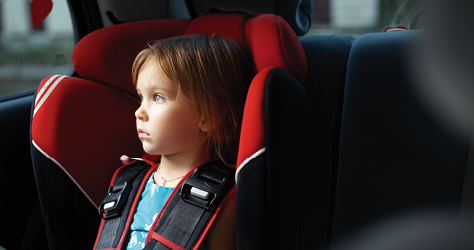We look at the maze of options for driving with children. Are you sitting comfortably?
Getting to know the car seat you need as your child grows from baby to toddler is part of being a parent. But despite well-publicised law changes in 2007, many are still getting it wrong. It is vitally important to keep up to date with the changes in legislation as, with a second or third child, using the car seat you bought for the first one might not be good enough.
At a glance
- Keep up to date with legislation, it may have changed since you had your first child
- If your child is not in the correct seat for their size and weight, you are breaking the law
- Do not buy a second hand car seat unless you know its history

How has the law on child seats changed?
Put simply, if your child is not in the correct seat for their size and weight, you are breaking the law. The driver of the vehicle is the one held responsible. The other element that is new is how long your child must be in a car seat. The law says it is until they’re either 135cm tall or the age of 12, whichever they reach first.
Are there any exceptions?
Yes, three.
- If you are travelling in a taxi or private hire vehicle
- If it is a short trip of unexpected necessity, e.g., going to hospital after an accident
- If there are two occupied child restraints on the back seat which prevents a third being fitted
In these circumstances a child need not be in the correct car seat, but in each case the child should use the adult belt that is available.
What are the penalties if I break the law?
You could face a fine of up to £500. However, there could be another hidden – and potentially more costly – expense. If you are in an accident, and your car insurer can demonstrate you were breaking the child-seat laws, deliberately or by accident, it can nullify your cover and you will not get a pay-out.
What if there are more passengers than belts or child seats?
Extra children may legally travel in the rear of a vehicle, but it is not considered safe. Every year up to 15 front seat occupants are killed by unbelted rear passengers flying forward in an accident. The law will be changing in May 2009 to prevent carriage of more passengers than there are seat belts.
Groups are the official classification for car seats, but some retailers muddy the waters by referring to them as Stages.
|
Ground
|
Stage
|
Child
|
|
0
|
One
|
For babies up to 10kg. Rear facing
|
|
0+
|
One
|
For babies up to 13kg. Rear facing
|
|
1
|
Two
|
For children weighing 9-18kg. Forward facing
|
|
2
|
Three
|
For children weighing 15-25kg. Forward facing
|
|
3
|
Four
|
For children weighing 22-36kg. Forward facing
|
Groups 2 and 3 are booster seats, booster cushions, or seats that convert into cushions. This can be confusing, so make sure your child is in the right weight range for the product you are considering.
What are the recognised safety standards for car seats?
Child restraints sold in the UK must conform to the United Nations ECE Regulation R44.03, R44.04 or any later version.
What is ISOFIX?
It stands for International Standards Organisation FIX and was designed as a way of making fitting car seats into cars idiot-proof. It has been adopted by some vehicle manufacturers, and is either standard on their cars, or available as a cost option. There is no evidence that it is a better way of installing car seats, it is just about making things simpler for parents. Refer to your car owner handbook for more information.
Does every forward facing car seat fit every car?
If you have a vehicle with sculpted seats, as on some sports models, there may be an issue with getting the car seat base to sit flat. The best advice is to try before you buy, and most retailers are happy to let you do this. Some car seat manufacturers have a car guide on their websites.
What else do I need to know?
Two things are very important. Do not buy a second hand car seat unless you know its history. And if you are in a crash, replace your vehicle’s seat belts and any car seats that were involved. There is no way of telling if the structural integrity has been compromised. It is better to be safe than sorry.
Where can I get more advice?
https://www.childcarseats.org.uk/ has masses of information, and is supported by the Department for Transport and RoSPA.
Tips for buying a car seat
Make sure your car seat will:
- Fit in your car (not all seats fit all cars)
- Comes with instructions you can easily follow
- Has different harness positions which you can adjust to fit your growing baby
- Has covers which are easy to remove and put back on after washing
Tips for safer driving
- Don’t place large or heavy objects on the back seat or parcel shelf in case of collision
- Get your baby in and out using the kerb side only
- Don’t let babies sleep in a car seat without checking
- Adjust the seat so your baby’s head doesn't flop forwards
- Always put a safety lock on car doors
- Never leave your baby alone in the car
- Metal parts can get very hot in the sun. Take care before you strap your baby in